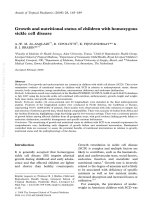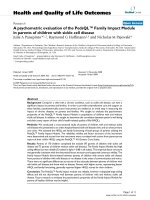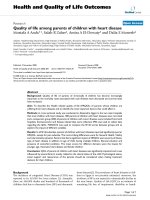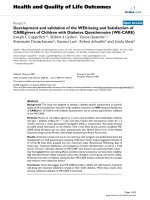The role of precautionary labelling for food allergens and the care of children with food allergies
Bạn đang xem bản rút gọn của tài liệu. Xem và tải ngay bản đầy đủ của tài liệu tại đây (5.74 MB, 135 trang )
The Role of Precautionary Labelling for Food
Allergens and the Care of Children with Food Allergies
A thesis submitted for the degree of Doctor of
Philosophy
Giovanni Antonio Zurzolo
B.Sc. Hons. (Biomedical Sciences)
School of Biomedical and Health Sciences,
Faculty of Health, Engineering and Science,
Victoria University, St Albans campus,
Victoria, Australia
February 2014
1
I dedicate this thesis to my father: Vincenzo Zurzolo and my mother:
Felicia Zurzolo nee Bruzzaniti and to my children: Felicia, Isabella,
Vincenzo and Giovanna Zurzolo. May this be a testament to you that
nothing is impossible. (Yes, daddy did it.)
Finally I dedicate it to my brothers: Vincenzo, Guido and Francesco
Zurzolo. All my most sincere gratitude for your support, love, and
encouragement in the past, present and future.
2
Publications, Presentations and Scholarships during my Candidature
Peer reviewed publications
Giovanni A Zurzolo, Michael L Mathai, Jennifer J Koplin, Katrina J Allen (2011)
"Precautionary food allergen labelling following new labelling practice in Australia."
The Journal of Paediatrics and Child Health 2013; 49 (4): E306-10. (This paper was
selected as 1 of 10 papers published in JPCH on Allergy/Immunology which have made
a significant contribution in 2011 and it is of a high standard.)
Giovanni A Zurzolo, Michael L Mathai, Jennifer J Koplin, Katrina J Allen (2012)
"Hidden allergens in foods and implications for labelling and clinical care of food
allergic patients." Current Allergy and Asthma Reports. 2012; 12 (4): 292-6.
Giovanni A. Zurzolo, Jennifer J. Koplin, Michael L. Mathai, Steve L. Taylor , Dean
Tey, and Katrina J. Allen (2013). "Foods with precautionary allergen labelling in
Australia rarely contain detectable allergen." The Journal of Allergy and Clinical
Immunology: In Practice. 2013; 1 (4): 401-6.
Giovanni A. Zurzolo, Jennifer J. Koplin, Michael L. Mathai, Mimi Tang and Katrina J.
Allen (2013). "Perceptions of precautionary labelling among parents of children with
food allergy and anaphylaxis." Medical Journal of Australia. 2013; 198 (11): 621-3.
3
Giovanni A Zurzolo, Katrina J Allen, Steve L Taylor, Wayne G Shreffler, Joseph L
Baumert, Mimi L.K. Tang, Lyle C. Gurrin, Michael L Mathai, Julie A Nordlee, Audrey
Dunn Galvin and Jonathan O’B Hourihane (2013). "Peanut Allergen Threshold Study
(PATS): validation of eliciting doses using a novel single-dose challenge protocol."
Accepted on August 15th 2013 to Allergy, Asthma & Clinical Immunology. 2013;
9(1):35.
Local &international presentations
Delivered a PowerPoint presentation on the 8th of April 2013 entitled, “The state of
play of precautionary labelling in Australia” to the Department of Allergy at the Royal
Children's Hospital, Melbourne.
Delivered an oral presentation on the 17th of June 2013 to the Gastro and Food Allergy
group meeting at The Murdoch Childrens Research Institute.
Delivered an oral presentation on the 24th of July 2013 to the European Academy of
Allergy and Clinical Immunology - World Allergy Organization (EAACI-WAO) at the
World Allergy & Asthma Congress in Milan, Italy. The results of these studies were
also used by Professor Katie Allen in her presentation to the EAACI-WAO World
Allergy & Asthma Congress in Milan, Italy, during the conference (June 21-26 2013) as
4
well as by the Scientific Conference Affairs Committee working group and the
international recommendations for precautionary labelling.
Delivered an oral presentation on the 9th of October 2013 to The Murdoch Childrens
Research Institute and The Royal Children’s Hospital tiled “The concept of thresholds:
do safe doses exist for food-allergic patients”?
Scholarships/Awards
I received a Victoria University Postgraduate Diversity scholarship to undertake my
PhD studies. I was also awarded a top-up scholarship from the Murdoch Childrens
Research Institute. I received a Secomb conference travel award from Victoria
University to present my work at the EAACI-WAO World Allergy & Asthma Congress
in Milan, Italy. In addition I also applied for and received a $1,500 travel grant from the
Murdoch Childrens Research Institute to present my work at the above-mentioned
conference.
Further to this I received an outstanding achievement award from the Faculty of
Biomedical and Health Sciences at Victoria University for Outstanding 3rd year research
student.
5
Contents
Publications , Presentations and Scholarships during my Candidature ........................................ 3
List of Tables and Figures .............................................................................................................. 8
List of Abbreviations and Acronyms.............................................................................................. 9
Summary Abstract ....................................................................................................................... 11
General Declaration .................................................................................................................... 17
Acknowledgements ..................................................................................................................... 19
Chapter 1: Introduction............................................................................................................... 21
Chapter 2: Literature review ....................................................................................................... 23
2.1 IgE and non-IgE mediated food allergy. ........................................................................ 23
2.2 How common is food allergy? ....................................................................................... 23
2.3 Is food allergy on the rise? ............................................................................................ 24
2.4 Food allergy and the atopic march................................................................................ 25
2.5 How is food allergy diagnosed? .................................................................................... 26
2.6 How is food allergy managed? ...................................................................................... 27
2.7 How common are adverse events in those with food allergy? ..................................... 29
2.8 What are the main causes of a serious adverse event in food allergy?........................ 30
2.9 How do industry and regulators deal with helping to keep foods safe? ...................... 33
Chapter 3: What is the evidence that precautionary labelling is useful? ........................... 41
3.1 How common are precautionary statements? ............................................................. 42
3.2 How often are people reading food labels? .................................................................. 44
3.3 Testing and analysis of food products for cross contamination ................................... 46
3.4 Consumer attitudes and behaviour towards precautionary labelling .......................... 48
3.5 Voluntary Incidental Trace Allergen Labelling (VITAL)TM ............................................... 51
3.6: Oral food challenges and the development of thresholds for the allergic consumer . 56
3.7 The state of play of precautionary labelling internationally ......................................... 57
Aims ............................................................................................................................................. 63
Hypothesis ................................................................................................................................... 65
Chapter 4: General materials and methods ................................................................................ 66
4.1 Precautionary allergen labelling following new labelling practices in Australia ........... 66
6
4.2 Consumer perceptions of precautionary labelling in families with food allergy and
anaphylaxis in Australia....................................................................................................... 66
4.3 Foods with precautionary allergen labelling in Australia rarely contain detectable
allergen ................................................................................................................................ 67
4.4 Hidden allergens in foods and implications for labelling and clinical care of food
allergic patients ................................................................................................................... 69
4.5 Peanut Allergen Threshold Study (PATS): validation of eliciting doses using a novel
single-dose challenge protocol ........................................................................................... 69
Chapter 5: Precautionary allergen labelling following new labelling practice in Australia ........ 71
Chapter 6: Perceptions of precautionary labelling among parents of children with food allergy
and anaphylaxis ........................................................................................................................... 74
Chapter 7: Foods with precautionary allergen labelling in Australia rarely contain detectable
allergen........................................................................................................................................ 82
Chapter 8: Hidden allergens in foods and implications for labelling and clinical care of food
allergic patients ........................................................................................................................... 88
Chapter 9: Peanut Allergen Threshold Study (PATS): validation of eliciting doses using a novel
single-dose challenge protocol ................................................................................................... 96
Chapter 10: Discussion, conclusion and future research direction .......................................... 109
Chapter 11: References ............................................................................................................. 117
Appendix 1: Consumer perceptions of precautionary labelling in families with food allergy and
anaphylaxis in Australia questionnaire ..................................................................................... 122
7
List of Tables and Figures
Table 1: Advisory statements
35
Figure 1: Undeclared allergens
30
Table 2: The current precautionary statements in use
39
Table 3: VITAL1.0 action levels
50
Table 4: VITAL 2.0 reference dose
51
Figure 2: VITAL 2.0 decision tree
52
Table 5: International comparison of mandatory declarations on processed foods
58
Table 6: International comparison of voluntary declarations on processed foods
59
8
List of Abbreviations and Acronyms
AD
Atopic Dermatitis
ASCIA
The Australasian Society of Clinical Immunology and Allergy
Arah 1, 2, 3
Arachishypogaea (major peanut allergen)
AR
AllergicRhinoconjunctivitis
CHI 2
Pearson Chi-Squared tests
CI
Confidence Intervals
DBPCFC
Double-Blind Placebo-Controlled Food Challenges
ED
Eliciting doses
ED10
Eliciting doses that cause objective reactions in 10% of the
population
ED05
Eliciting doses that cause objective reactions in 5% of the
population
ELISA
Enzyme-Linked Immuno Sorbent Assay
FARRP
Food Allergy Research & Resource Program
FAQL
Food Allergy related Quality of Life
FLG
Filaggrin
FSANZ
Food Safety Australia New Zealand
GMP
Good Manufacturing Practice
HREC
Human Research Ethics Committee
IgE
Immunoglobulin E
IgG
Immunoglobulin G
9
kUA/L
Kilograms Units of Activity PerLitre
LOAEL
Lowest Observed Adverse Effect Level
NIAID
National Institute of Allergy and Infectious Disease
NOAEL
No Observed Adverse Effect Level
MCRI
Murdoch Childrens Research Institute
µG PER G
Micrograms Per Gram
OR
Odds Ratio
OFC
Oral Food Challenge
PPM
Parts Per Million
SCIT
Subcutaneous Immune Therapy
SLIT
Sublingual Immunotherapy
Stata
Statistics and Data
SPT
Skin Prick Test
T-CELLS
T Helper Cells
TH1
T Helper Type 1
TH2
T Helper Type 2
VITALTM
Voluntary Incidental Trace Allergen Labelling
10
Summary Abstract
There is no current cure for food allergy; therefore consumers with food allergy rely on
accurate and detailed information on food labels in order to prevent an adverse reaction.
Manufacturers cannot guarantee that food products are free from allergens as cross
contamination can occur in several situations including but not limited to raw materials,
the actual premises, storage and distribution, manufacturing processes and cleaning
procedures. In order to alert the allergic consumer to the possible presence of trace
allergens, manufacturers have voluntarily added precautionary labelling to processed
foods. There are several variations to these statements, for example: “may contain traces
of”, “may be present “and “made on the same production line”. The main purpose of
this thesis is to understand the role of precautionary labelling in the care of children
with food allergies.
The thesis focuses on two key areas of research. The first explores current practices
with regard to precautionary labelling and the impact of these practices on food allergic
consumers. This involved examining the prevalence of precautionary labelling in
Australian supermarkets, perceptions and behaviours regarding precautionary labelling
for food allergic consumers, and the level of allergen contained in foods with
precautionary labelling. The second aimed to provide an evidence base to inform the
development of new precautionary labelling practices which would be more useful for
food allergic consumers. This involved a literature review and the development of
protocol for a study to inform risk assessments for precautionary labelling for peanut
allergic consumers.
11
European and US studies have shown that the use of precautionary labelling on
packaged goods within a supermarket setting is very high. In turn this suggests
consumers are exposing themselves to the possible risk of an adverse reaction by not
adhering to these statements. Furthermore some consumers believe that these statements
only protect the manufacturer from litigation.
My first study investigated the prevalence of precautionary labelling within Australia
for peanuts, tree nuts, egg, milk, sesame, crustaceans, fish, wheat and soy and to
investigate the uptake of the Voluntary Incidental Trace Allergen Labelling (VITAL) by
manufacturers. (The VITAL process is funded the Australian Manufacturing industry
and has been developed to replace all other forms of precautionary labelling. It
incorporates a new precautionary statement: “may be present”. The process encourages
manufacturers to undergo a more detailed assessment of their food products prior to
labelling a food product with a precautionary statement.) In total, 1355 products were
obtained from the supermarket setting and were investigated. Overall, 882 products
(65%) had a precautionary statement for one or more allergens noted above. The most
common allergens listed on precautionary statements were tree nuts (36.2%) and
peanuts (34.1%), followed by sesame (27.5%) and egg (22.6%). Of those that had
precautionary statements, “may contain traces of...” was the most common type of
precautionary label used on 392 products (29.0%). This was followed by “may be
present” on 172 products (12.7%). Although the uptake of the VITAL form of labelling:
“may be present” was low in comparison to other precautionary statements, there has
been an increase since 2009 when compared to a similar supermarket survey that was
undertaken in Australia.
12
My second study investigated consumer behaviour and perceptions regarding
precautionary labelling in those with and without a history of anaphylaxis. A
questionnaire-based study of a consecutive series of 497 parents of children attending
the Department of Allergy at the Royal Children’s Hospital Melbourne was undertaken.
Avoidance of foods with precautionary labels differed depending on the wording of the
precautionary statement, with 65% of participants ignoring the statement “made in the
same factory” compared with 22% for “may be present”. There was no evidence of a
difference in participants’ behaviour or perceptions depending on whether or not the
child had a history of anaphylaxis. Many statements are now being disregarded by a
sizeable proportion of allergic consumers, including those caring for children with a
history of anaphylaxis.
My third study investigated the level of cross contamination for peanut, hazelnut, milk,
egg, soy and lupin in processed foods with precautionary statements by visiting three
different Australian supermarkets in order to assess the risks taken by allergic
consumers choosing to ignore precautionary labelling in the Australian setting. Five
categories with a high prevalence of precautionary labelling were investigated, namely
chocolates, breakfast cereals, muesli bars, savoury biscuits, and sweet biscuits
(cookies). In total, 128 samples were assessed for allergen content analysis by EnzymeLinked Immuno Sorbent Assay (ELISA) for peanut, hazelnut, milk, egg, soy and lupin
protein. Of the 128 samples, only nine (7.0%) with precautionary labelling had
detectable levels of peanut with concentrations ranging from >2.5ppm to <50ppm for
13
whole peanut, or >0.63ppm to <12.5ppm for peanut protein. Of all other samples that
had precautionary labelling, none were found to have any detectable level of those
allergens. In addition, of the food products that did contain detectable traces of peanut,
none have been through the VITAL process.
My fourth study involved a detailed examination of the current literature regarding:
1) Precautionary labelling
2) Consumer behaviour and attitudes regarding this type of labelling
3) Risk to the consumer and the analytical results of products that bear advisory
labelling
4) The current debate regarding whether a tolerable level of risk can be obtained
in food allergy
5) The newly introduced Voluntary Incidental Trace Allergen Labelling
(VITAL) system in Australia.
The study involved a comprehensive review of the literature and showed that within
Europe and the US, precautionary labelling remains high; allergic consumers are not
avoiding products that bear these labels and analytical results of products that bear
advisory labelling contain minimal amounts of allergen which may not necessarily
cause severe allergic reaction. The research suggests that a large collaborative study
such as a one shot clinical trial is required to help provide further information about the
ability of allergic individuals to tolerate a predefined low dose of allergen.
14
My fifth and final study investigated the validity of eliciting doses of peanut using a
novel single dose protocol which may assist in the development of an objective risk
assessment for peanut allergic consumers. The paper outlined the importance of eliciting
dose (ED) for a peanut allergic reaction as it had been estimated for 5% of the allergic
population. This is referred to as ED05 and has been calculated and modelled as 1.5 mg
of peanut protein. This estimated ED05 was derived from multi dose oral food
challenges (OFCs) that use graded, incremental doses administered at fixed time
intervals, therefore the single dose to which the child reacts cannot be ascertained. The
current study is a multi-centre study involving three teaching centres: University
Hospital UCC Cork; Royal Children’s Hospital Melbourne, Australia; and General
Hospital, Food Allergies Centre, Massachusetts, U.S.A. A total of 375 participants
were recruited during their follow-up appointments in the Department of Allergy in
each respective centre. This paper aimed to assess the precision of the predicted EDO5
using a single dose (6mg peanut = 1.5mg of peanut protein) in the form of a cookie.
Validated Food Allergy related Quality of Life Questionnaires (FAQLQ) are available
for all age groups and will be self-administered prior to the OFC and 1 month after the
challenge. By using them we aimed to assess whether the impact of a positive “routine”
diagnostic OFC can be as beneficial as a negative OFC. The study suggested that the
single dose OFC, based upon the statistical dose-distribution analysis of past challenge
trials, promises an efficient approach to identifying the most highly sensitive patients
within any given food-allergic population.
In conclusion, this thesis shows that the prevalence of precautionary labelling is high
and that food allergic consumers including those with children who have a history of
15
anaphylaxis are commonly ignoring precautionary statements on food products. Also
those foods that do contain a precautionary statement infrequently contain any
detectable allergen and that population based threshold appears to be a more effective
risk assessment tool in the care of the allergic patient.
16
General Declaration
I, Giovanni Zurzolo, declare that the PhD thesis entitled ‘’The Role of Precautionary
Labelling for Food Allergens and the Care of Children with Food Allergies”
submitted for the degree of Doctor of Philosophy is no more than 100,000 words in
length including quotes and exclusive of tables, figures, appendices, bibliography,
references and footnotes. This thesis contains no material that has been submitted
previously, in whole or in part, for the award of any other academic degree or diploma.
Except where otherwise indicated, this thesis is my own work.
Signature
Date 2/12/14
17
PART A:
DETAILS OF INCLUDED PAPERS: THESIS BY PUBLICATION
Please list details of each Paper included in the thesis submission. Copies of published Papers and submitted and/or final draft Paper manuscripts should also
be included in the thesis submission
Publication Title and Details (e.g. date published, impact factor
Item/
Paper Title
Chapter
No.
Publication Status (e.g. published,
accepted for publication, to be revised and
resubmitted, currently under review, unsubmitted
but proposed to be submitted )
etc.)
5
Precautionary Allergen Labelling Following
New Labelling Practice in Australia
Published
Published in May 2013 in Journal of
Pediatrics and Child Health. I.F. 1.28
6
Perceptions of Precautionary Labelling among
Parents of Children with Food Allergy and
Anaphylaxis
Published
Published in June 2013 in The Medical
Journal of Australia. I.F. 3.32
7
Foods with Precautionary Allergen Labelling in Published
Australia Rarely Contain Detectable Allergen
Published in May 2013 in Journal of Allergy and
Clinical Immunology: In Practice. I.F. N/A
8
Hidden Allergens in Foods and Implications for
Labelling and Clinical Care of Food Allergic
Patients
Published in May 2012 in Current Allergy and
Asthma Reports. I.F. 2.5
9
Peanut Allergen Threshold Study (PATS): Published
Validation of Eliciting Doses using a Novel
Single-dose Challenge Protocol
Declaration by Giovanni Zurzolo
Published
Signature: Giovanni Zurzolo
September 17th2013 to Allergy, Asthma &
Clinical Immunology. I.F 3.03
Date: 2/12/14
18
Page 1 of 1
Acknowledgements
I would like to acknowledge the generous support, encouragement and assistance of
Professor Katie Allen and Dr Jennifer Koplin. You have both believed in my ability to
accomplish the task at hand and have provided me with educational and emotional
support. I will always be grateful for the time that I have spent here with you and for the
fine example of the pursuit of excellence you both have been for me.
I would also like to thank Associate Professor Michael Mathai who has provided
support and whose contribution has not gone unnoticed and to Professor Steve Taylor
from FARRP and Robin Sherlock from FACTA for their generous input as without it I
would not have been able to investigate an important area of research within Australia.
Thanks is also due to Nadine Bertalli for being my savour when it came to Stata,
Endnote and submitting papers. Thank you for all your help and for not getting upset
with me for all the times I came begging for help.
I also acknowledge Victoria University for providing me with a scholarship to carry out
my research, Victoria University Disability Liaison Unit and Bridget Stockdale who
have provided me with assistance for which I am grateful. I also thank The Murdoch
Childrens Research Institute and The Royal Children’s Hospital for providing me with a
place to undertake my research.
19
To the participants and their families who took part in the studies: without them none of
this would have been possible.
And finally to the ever expanding HealthNuts and School Nuts team; Deb, Leone,
Helen, Tina, Rachel, Oliva, Megan, Kaye, Noor, Alica, Jana, Lucinda, Tamara, Dean,
Thanh and Jeeva, it has been a pleasure to work with you all.
20
Chapter 1: Introduction
It is currently estimated that one in ten children has a food allergy; the actual cause is
uncertain at this stage but the prevalence may continue to rise. The management of food
allergy basically involves abstinence from any food product that may contain an
allergen to which a child is allergic and ongoing management including regular reviews
to ensure the allergic plan is effective and to assess for tolerance development when
appropriate. This includes consideration of the reintroduction of the allergen later in the
child's life to see if that allergy has resolved. Processed foods are often used by parents
of young children because of their accessibility and ease-of-use. Use of processed foods
is more complicated for parents of children with food allergy because of concerns
regarding trace contamination of allergens.
There are current regulations that deal with added ingredients in food products
(including food allergens that are known to cause reactions in allergic children). The
process is well governed and has been successful in alerting the consumer to the
presence of added allergens and is referred to as mandatory labelling. However, modern
manufacturing techniques cannot guarantee that a food product may be free from cross
contamination from certain allergens due to processing, the use of shared equipment or
exposure to other allergens through processing.
Therefore the manufacturing industry has incorporated the use of precautionary food
labelling on many processed foods. The aim of precautionary labelling is to alert the
consumer to the possible presence of certain allergens from cross contamination; the
food ingredient has not been intentionally added to the product. An allergen that has
been added during the manufacturing process requires a mandatory statement to that
21
effect. The types of statements that are used in precautionary labelling vary from “may
contain traces of xxx (allergen)” to “made in the same premises as xxx (allergen)”.
There is an abundance of these statements and there is no current regulation which
controls their use. Due to the lack of regulations regarding precautionary labelling, it is
uncertain whether or not there is any scientific process that validates the use of
precautionary labelling on processed foods.
There is a current gap in the literature regarding the prevalence of precautionary food
labels within the dominant supermarket companies in Australia and the behaviours and
attitudes of parents with children who have food allergies. Also there is no information
in Australia regarding the risk undertaken by parents should they choose to ignore
precautionary labelling or whether products that contain precautionary labelling contain
detectable levels of allergen. This thesis will address these gaps in the literature and
provide evidence to inform precautionary labelling practices in Australia and
internationally.
22
Chapter 2: Literature review
2.1 IgE and non-IgE mediated food allergy.
Acute allergy to food is mediated by immunoglobulin E (IgE) antibodies (1) which
regulate systemic release of histamine from mast cells (2). Evidence exists of non-IgE
mediated food allergies or delayed food allergies which may be mediated by IgG
amongst other mechanisms (1). However these types of food allergy are poorly defined
and rarely result in anaphylaxis.
2.2 How common is food allergy?
In Australia the most common types of food that children are sensitised to are peanut:
8.9% (95% CI, 7.9-10.0), egg: 16.5% (95% CI, 15.1-17.9), cow’s milk: 5.6% (95% CI,
3.2-8.0) and sesame seed: 2.5% (95% CI, 2.0-3.1), with shellfish being rare in children.
Adults are less often allergic to egg and milk (since most children grow out of these
allergies) but more often to shellfish (3, 4).
An increase in prevalence of food allergy has been reported in developed countries as
Sicherer 2010 et al. (2001) demonstrated in their study where they sought to determine
the US's prevalence of self-reported peanut, tree nut, and sesame allergy in 2008 and
compare results with similar surveys conducted in 1997 and 2002. The authors' results
show that the population prevalence of childhood tree nut allergy increased significantly
across the survey waves (1.1% in 2008, 0.5% in 2002 and 0.2% in 1997) (5).
23
2.3 Is food allergy on the rise?
The prevalence of food allergy has been studied in the general population (6). Sicherer
et al. contacted 4855 participants through a random sampling of telephone numbers,
with a response rate of 53%. The researchers reported an increase in self-reported
peanut allergy from 0.6% to 1.2% in children from 1997 to 2002. Although this increase
was significant in children, it was not statistically different in adults (6). In Great Britain
the perceived prevalence of peanut allergy has been suggested to be approximately
0.5% in the adult population and 0.6% in children (n=124) (7). In Australia, Osborne et
al. (2011) sampled a birth cohort of approximately 2848 infants (73% participation rate)
from the population at 12 months of age. The authors' results revealed that more than
10% had food allergy to one of the common allergenic foods during infancy with peanut
allergy at 3.0% (95% CI, 2.4-3.8); raw egg allergy at 8.9% (95% CI, 7.8-10.0); and
sesame allergy at 0.8% (95% CI, 0.5-1.1). The diagnosis of food allergy was made
using the gold standard: the oral food challenge, in a large unselected population. The
strength of the study included the high participation rate and the high attendance rate at
the food challenge clinic (84%) which would minimise the effect of selection bias. Also
researchers performing the challenges were blind to both the SPT wheal size and the
history of ingestion reaction (4). The study by Osborne et al. is unique because accurate
or current prevalence data, particularly in infants and children younger than 3 years old,
has not been available; previous estimates were based on parent or self-reported
questionnaires or surveys. There have been few studies that confirm the prevalence of
food allergy through the gold standard of the oral food challenge; however, even the
few that have used the gold standard for confirmation of food allergy have been limited
due to their poor participation rate (8).
24
2.4 Food allergy and the atopic march
The term atopic march refers to the natural history of allergic disease which begins with
atopic dermatitis (AD), and progresses to food allergy, allergic rhinitis, and asthma (9).
The atopic march affects approximately 20% of the population in developed countries
(10). AD is a common chronic pruritic skin disease seen in infants and children. A
search of the literature reveals that there may be a positive association between food
allergy and AD (11-16). Of the literature that is available, researchers have investigated
the association of peanut, cow's milk, and egg allergies with AD. However there is
debate about which comes first: AD then food allergy or the reverse (17). Several
authors
have
been
able
to
demonstrate
an
association
between
food
sensitisation/ allergy and A D (18, 19). Eller et al. (2009) reported that 43% of their
cohort that had sensitisation to food also had AD (n=562). The researchers also found
that children who had sensitisation over a greater period of time had the more rigorous
form of AD (12).
Kijima et al. (2013) showed that food allergy is a burden on society because of the
development of other allergic disease. It can lower the quality of life and work
productivity of affected patients and their families. The authors interviewed 3321
participants and asked questions regarding family history of atopic disease such as
Atopic Dermatitis (AD), Bronchial Asthma (BA), Allergic Rhinitis (AR) and also of
Food Allergy (FA). Histories of AD, BA, AR, and FA were based on a doctor’s
diagnosis at any time during the participant’s life from birth to the present day. The
investigators showed that FA significantly raised the risk of allergic disease comorbidity
(AD, BA, and AR), especially AD, and critically increased the number of diseases (20).
25









